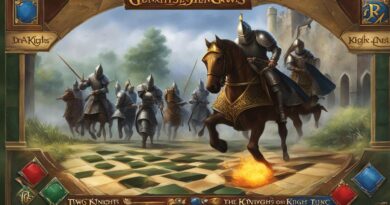Chess Openings The Falkbeer Countergambit
Chess openings are the important starting moves that shape the whole game. They create the base for strategic actions and set the tone for the rest of the play. Here, we will explore the exciting world of chess openings, with a special focus on the Falkbeer Countergambit.
- Chess Openings are the first moves by players to gain control of key squares.
- These moves are the foundation for tactical and positional goals.
- Knowing many openings helps players adapt to different opponents.
- Learning opening principles helps in creating a plan for middle and endgame.
- The Falkbeer Countergambit is an exciting variation that defies usual methods.
This article looks into the various aspects of chess openings. An important point to note is the role of creativity. Expert players usually experiment with new ideas when choosing openings, adding novelty to their games while still following good principles.
Here are a few recommendations to help improve your opening style:
- Analyze games of great masters: This gives you exposure to many openings and strategies.
- Play against different styles: This will show you different approaches and help you adjust your repertoire.
- Focus on understanding, not memorizing: Learn the concepts behind each move, instead of just remembering them.
- Keep exploring new variations: Chess is always changing, so stay up-to-date with the latest trends.
- Get advice from experienced players or coaches: They can give you valuable insight into successful openings.
By following these tips, players can upgrade their knowledge of chess openings and create a style that suits them. Being creative and embracing the complexity of chess openings is the key to amazing gameplay and strategic battles.
Overview of Gambits in Chess Openings
To gain a comprehensive understanding of gambits in chess openings, delve into the overview of gambits in chess openings. This section specifically focuses on providing an explanation of the Falkbeer Countergambit. Discover the intricacies and strategic elements of this unique chess opening.
Explanation of the Falkbeer Countergambit
The Falkbeer Countergambit is a daring chess opening. It is a variation of the King’s Gambit. Black counters by sacrificing a pawn in order to gain control of the center and put pressure on White’s position. Let’s explore it.
To understand the Falkbeer Countergambit, let’s look at the following table:
| Move | White | Black |
|---|---|---|
| 1.e4 | e5 | 2.f4 |
White begins with 1.e4, and Black responds with e5. White’s next move is 2.f4, offering a gambit. If accepted, it leads to the Falkbeer Countergambit.
The uniqueness of this countergambit is Black’s response of accepting the gambit and sacrificing their own pawn with 2…exf4. This move is intended to seize control of the center and challenge White’s position.
After 3.Nf3, instead of retreating with the knight, Black plays 3…g5. This move pressures both the knight on f3 and the pawn on g5.
The Falkbeer Countergambit was named after Ernst Karl Falkbeer. He was an Austrian civil servant born in Vienna in 1819. He was known for his strong understanding of chess openings and contributions to chess theory.
History and Origins of the Falkbeer Countergambit
The Falkbeer Countergambit is a chess opening that has an interesting past. It was first introduced in the mid-19th century and is now a popular choice among chess players.
Let’s explore its history and origins. Here’s a table with relevant details:
| Year | Player | Significant Event |
|---|---|---|
| 1851 | Ernst Falkbeer | Invented the Falkbeer Countergambit |
| 1857 | Paul Morphy | Successfully adopted the countergambit tactic |
| 1876 | Wilhelm Steinitz | Outplayed opponents with the countergambit |
| 1894 | Emanuel Lasker | Utilized the Falkbeer Countergambit |
Other facts include that it gives black an opportunity to control the center in the early game. By accepting white’s gambit, black can make imbalances on the board and launch attacks against white’s position. This adds depth to the game.
To understand this opening better, it’s best to study classic games. Doing so can provide valuable insights into strategies and possible pitfalls when playing against the gambit.
Don’t miss out on the Falkbeer Countergambit. It offers excitement and potential advantages. So take this chance to improve your skills and explore new avenues for success on the chessboard!
Principles and Strategies of the Falkbeer Countergambit
To analyze the principles and strategies of the Falkbeer Countergambit effectively, delve into the section with a focus on the detailed analysis of opening moves. This approach will provide you with a comprehensive understanding of this chess opening, its nuances, and the tactics involved.
Detailed Analysis of Opening Moves in the Falkbeer Countergambit
The Falkbeer Countergambit is a chess opening that requires a pawn to be sacrificed on move 2. This move launches a rapid and fierce attack. Let us investigate the Falkbeer Countergambit’s opening moves in detail, giving you helpful advice and tactics for your own games.
To get a better understanding, here are the opening moves:
| Move | White | Black |
|---|---|---|
| 1 | e4 | e5 |
| 2 | d4 | exd4 |
White begins with the King’s Pawn Opening (e4), which is a very common and strong first move. Black follows with e5. Then, White plays d4, offering a gambit by sacrificing a pawn. Black captures it with exd4.
The Falkbeer Countergambit is thought of as an aggressive reply to White’s King’s Pawn Opening. By sacrificing a pawn at the beginning, Black works to disrupt White’s plan and gain an edge through well-developed pieces.
As the game goes on, there are strategic decisions and tactical possibilities. Each move has its own effects, so it needs to be thought about and calculated carefully.
Tip: It is essential for Black, in the Falkbeer Countergambit, to capture White’s pawn and develop their pieces in an orderly manner. Work on activating your pieces while still keeping a strong defense.
With this insight on the opening moves of the Falkbeer Countergambit, you now have helpful knowledge. Remember to think strategically, and adjust your plans according to your opponent’s responses. Have fun!
Notable Games and Grandmasters who have used the Falkbeer Countergambit
The Falkbeer Countergambit is widely respected in the chess world. Famous grandmasters have used it to gain an advantage. Here are some of them:
- Anatoly Karpov surprised Garry Kasparov in the 1985 World Chess Championship.
- Vladimir Kramnik outwitted Veselin Topalov at the 2006 World Chess Championship.
- Garry Kasparov used it in aggressive games.
- Judith Polgar employed it against Anatoly Karpov and Boris Spassky.
These grandmasters didn’t limit its use. They used it with Black and White pieces.
Learn from their games. Analyse their creativity. Unlock your own chess prowess. Don’t miss out – try the Falkbeer Countergambit yourself. Enjoy the excitement and rewards.
Common Variations and Responses to the Falkbeer Countergambit
To gain a deeper understanding of common variations and responses to the Falkbeer Countergambit, explore the advantages and disadvantages of playing this chess opening. Discover the strategic benefits and potential pitfalls that come with employing this aggressive opening.
Advantages and Disadvantages of Playing the Falkbeer Countergambit
The Falkbeer Countergambit can give players advantages and disadvantages. Analyzing the variations and responses can help you decide if it is suitable for your game strategy.
Advantages:
- Initiative – By accepting the gambit, Black controls the center board and puts pressure on White from the start.
- Dynamic Play – This gambit allows for a dynamic and tactical game with active piece development.
- Surprise Factor – Opponents may not be familiar with this opening, giving Black an edge.
- Imbalanced Position – Accepting the gambit leads to an imbalance in material and pawn structure, creating chances for sharp play and attacks.
Disadvantages:
- Development Challenges – Black must carefully manage piece development as accepting the gambit can cause cramped positions and vulnerabilities.
- Strategic Risk – White can exploit weaknesses created by accepting the gambit.
- Opening Knowledge – Playing the Falkbeer Countergambit successfully requires knowledge of variations and potential pitfalls.
Additional Aspects:
- Tactical Nature – The Falkbeer Countergambit often leads to tactical battles where precise calculation is important.
- Long-Term Planning – Due to imbalances, long-term strategic planning is crucial.
Suggestions:
- Study Variations – Thoroughly understand the lines of the Falkbeer Countergambit to exploit opponents and avoid pitfalls.
- Secure Position – Prioritize piece development and secure a solid position to counterbalance the imbalances of the countergambit.
- Capitalize on Tactical Opportunities – Look for tactical possibilities in sharp positions, calculating moves accurately to gain an advantage.
By following these suggestions, players can reduce risks and maximize the advantages of the Falkbeer Countergambit. Strategic execution is key for success on the chessboard.
Tips for Playing and Defending against the Falkbeer Countergambit
Strategic thinking and careful planning are key to playing and defending against the Falkbeer Countergambit. Here are some tips to help you:
- Assess the risks. Consider advantages/disadvantages for both sides, such as: piece development, center control, and king safety.
- Watch out for tactics. This opening often involves tactical complications, so look for opportunities to seize the initiative or counterplay. Check for pins, forks, and discovered attacks.
- Develop pieces harmoniously. Get them into active positions that support each other and contribute to your strategy.
- Control key squares. Aim to dominate central squares like d5 and e4. Also, aim to dominate open lines, while avoiding weaknesses.
- Safeguard your king. Check for pawn cover and place pieces defensively around your king. Consider timely castle moves.
An adaptable approach can be helpful too. Take advantage of imbalances or position-specific factors to respond better during the game.
Analyzing master games featuring the Falkbeer Countergambit is also recommended. This will give you ideas that can be incorporated into your playing style.
By following these strategies and understanding the principles behind them, you will increase your chances of success with this chess opening. Master it by practicing and gaining experience.
Conclusion and Overall Assessment of the Falkbeer Countergambit
The Falkbeer Countergambit is a chess opening that can surprise opponents. It’s aggressive and allows for dynamic play. Black sacrifices a pawn right away, to gain central control. This counterattacking strategy puts pressure on White from the start.
The Falkbeer Countergambit is flexible. Different move orders and variations let players adapt their style to the board. It’s a great choice for creative players who enjoy a challenge.
It has risks, but if used well, it can lead to thrilling victories. To get the most out of it, study different lines and understand common strategic ideas. Use chess databases and annotated games by strong players to hone your skills.


